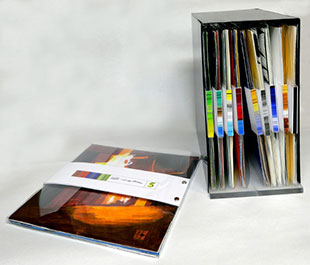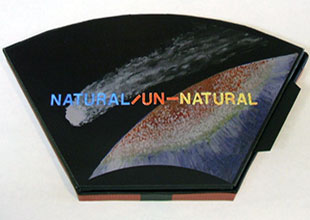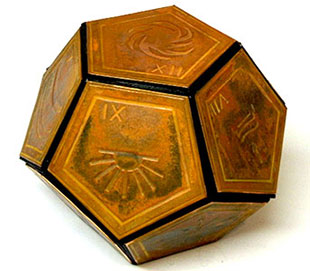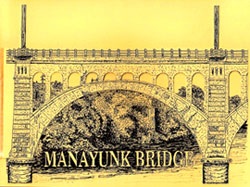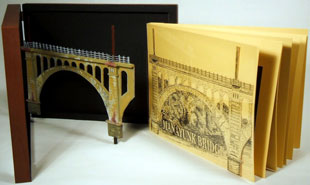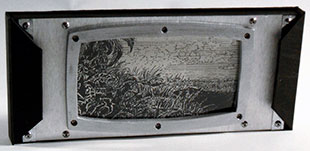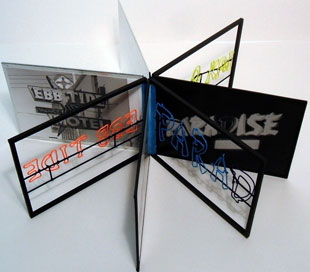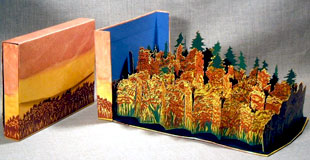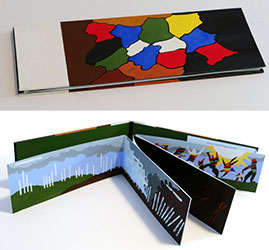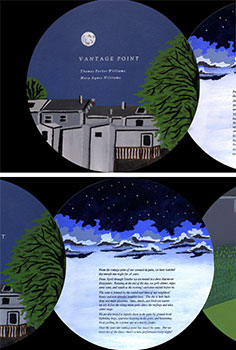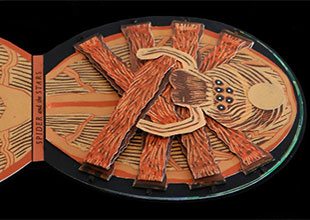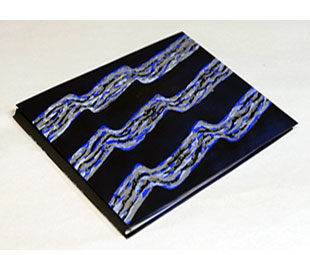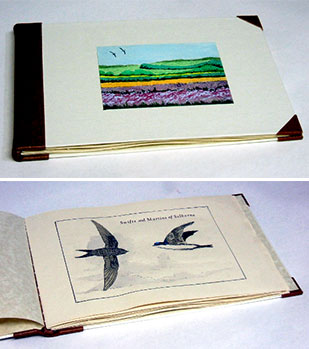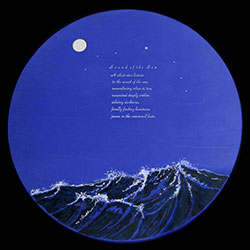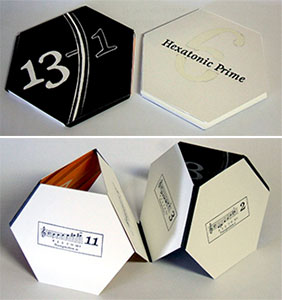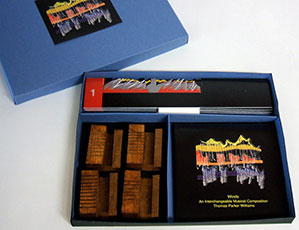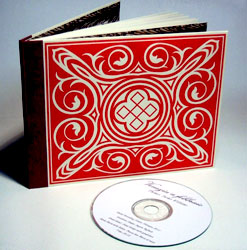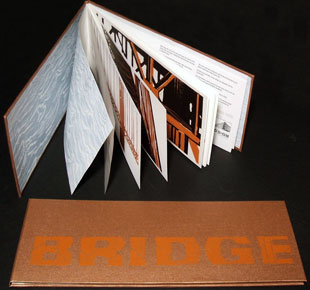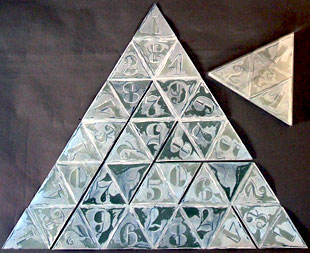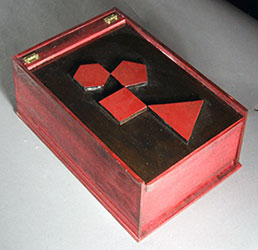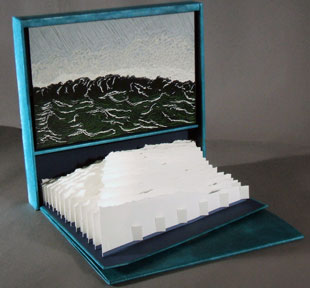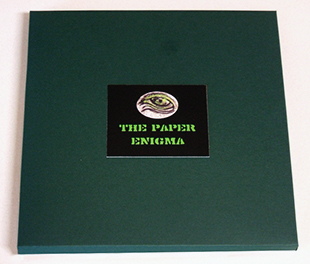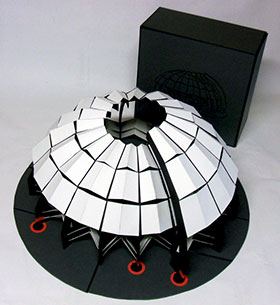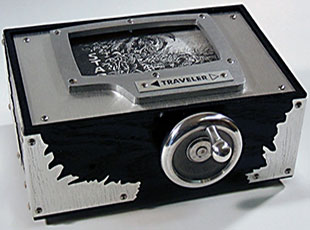
Thomas Parker Williams ~ Pennsylvania |
Share this page: |
| Thomas Parker Williams: " I started to make artist books in 1998. They are all handmade using various printing and cutting techniques." | |
Books with music |
|
Passages Book – 10 polycarbonate envelopes with catch and colored spectrum panel Each envelope 12.25 x 12.25 x .5”. Each of the 9 sections contains from 3 to 7 double sided panels on Strathmore acrylic paper with magnet and steel areas. Medium - Panels, Acrylic ink, watercolor, dry pigments in alkyd medium, colored pencil and pigment markers. Case – 13” x 13” x 7.5, cast acrylic. Envelope no. 10 contains digital music, video files and text. Original music composition, "Passages" composed, performed and recorded by Thomas Parker Williams. All artwork, case, envelopes and music by the artist. Thomas Parker Williams: “’Passages,’ a work in my WORDLESS – Painted and Drawn Narratives series, is a nine-part artist book with an accompanying nine-part musical score. All art, music composition and performance is my work. “First, I composed the musical suite as an impression of a journey through periods of a possible lifetime that may or may not resemble my own. The music is illustrated by drawings on double-sided paper panels executed in a variety of inks and wet media. There are from three to seven panels for each of the nine parts of ‘Passages’ for a total of 41 panels with 82 original drawings. “Each drawing incorporates a badge in the lower right-hand corner that references colors of a particular position of the spectrum. The badge contains an arrow and a dot indicating whether the drawing is considered primary or secondary. “Each panel includes one magnet and three small pieces of steel. This allows for linking the images together in many combinations to illustrate the multiple pathways, choices, or alternate universes that may exist in a lifetime journey. “The panels for each passage are enclosed in a polycarbonate envelope with a closure clasp illustrated with the number of the passage, a color spectrum, and a graphic representation of the musical elements. All nine envelopes, plus a tenth with information and electronic files, are contained in an acrylic case.” |
|
Revelation 11" in diameter x 2" high. Seven-sided wood case. Laser-cut face plate. Copper panels with patina and laser transfer design. 10 printed laser-cut panels with mechanical parts for actuation. Instruction sheet included. Signed and numbered by the artist. Thomas Parker Williams: "Revelation is an interactive artist book that uses a new construction I call the cascading rotary structure. "I was inspired by the cut-up method of writing developed by Brion Gysin and William S. Burroughs in the 1950s. For the text I used excerpts from the final book of the New Testament, 'The Revelation of Saint John the Divine.' It is the most Burroughs-like book in the Bible. "The illustrations are my interpretations of the original first-century text. Its powerful, often violent imagery was thought to predict the end times, and was used as a weapon against various factions of believers. Over the centuries, this book has created more dogma and fomented more persecution than any other text in the canonical scriptures. "Modern scholarship has established that 'The Revelation of Saint John the Divine' was written in code, and meant as a work of protest, a political tract documenting Roman conquest and occupation. For example, the 'number of the beast' refers to the numerical value, in Hebrew, of the name of a Roman emperor. "Starting at Revelation's first 'Alpha and Omega' image, the viewer rotates the center knob to the left, or counter-clockwise. Ten laser-cut panels advance, each one revealing image and text combinations seen through the fifteen windows of the face plate. When the ending 'Alpha and Omega' appears, the viewer resets the sequence by rotating the knob clockwise. Turning the knob in one direction, then the other, can produce dozens of unpredictable combinations. Revelation allows the viewer to interactively cut-up the text to, as Burroughs states, really read between the lines." |
 Click image for more Click here for the link to YouTube. And a youtube of resetting the book Click here for the link to Instagram |
| Natural / Un-Natural By Thomas Parker Williams Philadelphia, Pennsylvania: Thomas Parker Williams, 2015. Edition of 11. 6 x 10 x 1" in case, extends to 19" diameter. Digital prints of 24 original painted panels. Arranged in a circular accordion structure with 12 double-sided sections. Tyvek hinges. Companion video (8 minutes 23 seconds) on DVD. Signed and numbered by the artist. Thomas Parker Williams: "Prints of twenty-four painted panels, executed with dry pigments in alkyd medium, represent events affecting our environment and actions exacerbating these events. Each panel is divided into two sections to give two possible visual interpretations. "Events described by the panels are: extra-terrestrial impacts, solar storms, volcanic activity, eruptions, earthquakes, tsunamis, wind, dust storms, rain, flooding, hurricanes, storm surges, tornadoes, blizzards, drought, wildfires, earth shifting events, glacier melting and calving, permafrost melting, and sea level rise. "The climate is changing, we cannot control the events that threaten our environment but we could have controlled our actions. "Now we may be powerless to stop this process." $300 |
|
| Vessel of Secrets By Thomas Parker Williams Philadelphia, Pennsylvania: Thomas Parker Williams, 2015. Edition of 2. 6.25 x 7.25 x 7.5" closed, 13.5 x 20 x 2.8" fully open. Dodecahedron structure. Exterior panels of embossed copper sheet with patina. Twelve paintings in alkyd medium and dry pigments on paper structures outlined with Venetian marbled paper. Digitally printed text. Housed in painted wooden box with cradle and magnets to hold sculpture in place. Colophon sheet laid in. Signed and numbered by the artist. Thomas Parker Williams: "Vessel of Secrets was inspired by 'The Nature of Things' written c. 50 BC by the Roman philosopher and poet Lucretius. "The shape of this vessel is a dodecahedron, a twelve-sided perfect solid, which represented the universe in the ancient world. From 'The Nature of Things' I distilled twelve ideas, or secrets, I consider to represent some of the fundamental ways the universe functions. The ideas deal with the physical sciences, biology and philosophy, and are personal observations. "Each of the twelve secrets is represented by an embossed copper plate on the exterior of the structure and a paper pyramid supporting a miniature painting on the interior of each side. The rear of each pyramid structure contains the text of the secret. "The structure is held closed by small powerful magnets and can be easily opened when rotated to the proper angle. Once opened the entire structure can be flattened for display or partially flattened to show exterior and interior surfaces." $3,500 (One Copy Available) |
|
Manayunk Bridge Standard Edition: 8.5 x 11"; 7 leaves including covers. 5 pinhole photograph silver gelatin prints. 2 digitally reproduced ink drawings. Cut paper overlay of bridge over cover. Deluxe Edition: 12" x 9.5" x 2"wood case with clear cover containing 3D relief model of one of the arch sections of the bridge and the book of pinhole photographs. Update: “An interesting note about the real Manayunk Bridge. Since the early eighties it was a decommissioned railroad bridge that was built in the 1920s. For years it sat there falling apart but the city has now re-created it as our version on the High Line. It is open to pedestrian and bike traffic and it connects to a parkway on the other side of the river from us. We now have a great place to walk.”
|
|
| The Travelers By Thomas Parker Williams Philadelphia, Pennsylvania: Thomas Parker Williams, 2012. Edition of 5. 5" x 11" x 1" closed, extends to 3.5" x 157.5"; 15 panels. Digital print of original ink drawings on scroll. Housed in viewer constructed of wood and aluminum bound with black Tyvek. Magnet closure at each end. Signed and numbered by the artist. These two digital print versions are based on the original pen and ink unique books by the same name – Traveler No. 1 and Traveler No. 2. Thomas Parker Williams: "The Travelers are book objects with unique drawings that are viewed through the windows on the top panels and are moved by sliding the unfolded drawing through the case. The viewer travels through imaginary landscapes as if in a moving vehicle, viewing an ever changing horizon. "Traveler No. 1 (SOLD): The journey starts in a wooded area, moves over land, mountains, and into the sea, passes an island, and comes to rest on a shore. "Traveler No. 2: The journey starts in a desert oasis, moves over the edge of a canyon, moves down to the river and over a waterfall emerging over mountains and clouds, and comes to rest on an arctic ice shelf. " Traveler No. 1 (SOLD) $375 Traveler No. 2 (Last Copy) |
|
| Neon By Thomas Parker Williams Philadelphia, Pennsylvania: Thomas Parker Williams, 2011. Edition of 5. 7 x 10 x 1.5”; 9 pages. Six silver gelatin prints . Three painted wire sculptures (wood frames) . Cover of thin gauge galvanized steel with title in wire. Bound with dyed Tyvek. Thomas Parker Williams : "Neon is a study of classic neon signs featuring three 1950s-era motels in Wildwood, a popular beach town in New Jersey. Dozens of these motels (with their ubiquitous neon signs) were built in mid-century, but many are no longer standing. “Neon combines day and night photographs that I took twenty years ago with a 4x5 camera, with wire sculptures that reproduce the neon tubes of each sign. The wire sculptures are painted in fluorescent colors, vibrating between the black and white photographs. "The cover is made of thin gauge galvanized steel, a material typically used in the construction of these signs; the title of the book is also rendered in wire as a brightly-colored neon tube. ... "Neon can be opened to display any of the three sets of images or opened in a circular form to display all of the images." $975 (Last Copy) |
|
| Mountainside Matrix By Thomas Parker Williams Philadelphia, Pennsylvania: Thomas Parker Williams, 2010. Edition of 8. 8 x 11.25 x 1.75" closed, opens to 8 x 11.75 x 16"; 72 paper panels. Seven colors, printed double-sided (reduction linocut), cut with scroll saw, mounted on a dyed tyvek 6 x 12" accordion matrix in case that is bound in dyed tyvek and printed with single color linocut front, back, and sides. Magnetic catches secure the structure in the open and closed positions. Signed and numbered by the artist. Thomas Parker Williams: "Mountainside Matrix is a book structure representing the natural complexity of a mountainside forest in autumn. "The basic structure is made up of six, 12-panel parallel accordions tied together at each end and spaced apart to allow for collapsing to a flat form. Additional tie points are added in 20 places to allow for uniform movement when collapsing and extending. Magnetic catches secure the structure in the open and closed positions." $750 (Last 2 copies) |
|
| Luminice Press, a collaboration of husband and wife Thomas Parker and Mary Agnes Williams. Thomas Parker Williams: "In 2009 I began collaborating with my wife Mary Agnes Williams, a pinhole photographer. In 2013 we started Luminice Press, incorporating letterpress printing in artist books and broadsides. I designed and built a hand press with electronic gauges, also called the Luminice Press." | |
American Progression 12.25” x 4.25” x .5”; 12 pages. Double-sided accordion. Printed on Stonehenge Polar White papers. Pochoir on paper over board. In slipcase with mylar insert. Illustrations on six panels with oil based inks over flood coats. Pochoir using 50 stencils. Letterpress printed from polymer plates. Concept, design, illustrations, pochoir, printing, binding by Thomas Parker Williams. Original text, text layout, printing by Mary Agnes Williams. Luminice Press: "In images and text, our artist book ‘American Progression’ encapsulates the sources of deep fissures in this country: white supremacy, the legacy of slavery, the constant influx of immigrants. And yet, there is progression beyond the fear and hate that separate Americans, as many find community and joy together, and share hope for the future." Text Excerpts: “In 1950, 89.5% of Americans identified as white . . . By 2050, whites will be a minority (47%) . . . Many on the right bitterly resent losing privilege and power . . . . . . They remember the easy days before civil rights . . . When an ordinary white man was always better and smarter . . . When the sheriff looked the other way . . . . . . Desperate to hold on, they search for a leader who will raise them up again, a savior who will take control and lead them back to the white promised land. …For hundreds of years African slaves were submerged in American soil: endless brutality in endless fields of cotton, rice, tobacco, sugar cane . . . We shall rise . . . . . . Unlike Africans, Latino families have been desperate to escape their homes for a better, safer place, risking everything to migrate north . . . We must walk . . . . . . Poverty, injustice and hate are realities in America . . . Despite it all, people still find joy and see hope for the future . . . Black, brown, white . . . We can dance!” |
|
Vantage Point Book: 9.375" diameter, opens to 72". Eight pages and envelope on Stonehenge print paper. Envelope contains digitally printed insert, four panels, opens to 18" x 8.25". Binding with Radial hinges. Illustrations with Oil-based pochoir, 50 colors/50 stencils. Inks of Dry pigments in burnt plate oil and alkyd medium. Hand-painted accents in acrylic ink. Text handset in Janson, Janson Italic, and Goudy Italic. Letterpress printed. Concept, design, illustrations, printing, binding by Thomas Parker Williams. Concept, design, text, handset type, printing by Mary Agnes Williams. Deluxe version in Laser cut black acrylic case 10.5" diameter with laser cutting by Freefall Laser. Thomas Parker Williams: "Vantage Point is a book of contrasts. Most of the book describes, in pochoir images and letterpress printed text, familiar sights like lightning bugs, song birds, and the rising moon that we have enjoyed watching in the evening over 28 summers. At the end of the book we relate how we observed an object in the sky that we could not identify, as well as our efforts, with data and AutoCAD software, to present a reasoned hypothesis about the object's possible placement, trajectory, and flight paths." Vantage Point: “From the vantage point of our screened-in patio, we have watched day morph into night for 28 years. From April through October we are treated to a show that never disappoints. Relaxing at the end of the day, we grill dinner, enjoy some wine, and watch as the evening’s activities unfold before us. The scene is framed by the varied roof lines of our neighbors’ homes and two splendid boxelder trees. The sky is both backdrop and main attraction. Stars, clouds, and birds are warm-up acts before the rising moon peeks above the rooftops and takes center stage. We are also treated to hijinks closer to the patio by ground-level lightning bugs, sparrows hopping in the grass, and hummingbirds jostling for a prime spot at a nearby feeder. Over the years our vantage point has stayed the same. But we never tire of the show – there’s a new performance every night! … “No matter how often we have seen the moon rise, it is always thrilling, as if we were witnessing it for the first time. A full moon, especially, still has the power to enchant when it peeks in and out from behind the tree and rises majestically above the rooftops. We had no idea when we purchased our home that our singular vantage point would give us so many hours of joy, fascination, and wonder.” “What was that?”: “After watching day turn to night from our patio vantage point since 1995, on May 16, 2020 we were surprised by something in the sky we could not identify. Shining in the last rays of the setting sun, it moved extremely quickly from point to point, hovering and changing direction twice. There was no sound, and no acceleration or de-acceleration. It disappeared after 4 seconds.” $1,900 standard |
|
Spider and the Stars 7.5" x 8" closed; pop-up opens to 19" x 24"; 16-page movable book/codex. Includes pop-up spider that opens to 19" x 24". Letterpress printed. Pochoir images. Cover Laser cut wood. Oil-based pochoir printed paper cover. Pop-up and Carrier with Reduction linocut; cut with scroll saw; pages cut using laser-cut steel template with Arches book paper. Illustrations of Oil-based pochoir over linocut flood coats with hand-painted accents. Inks of Oil-based relief inks and dry pigments in burnt plate oil. Text Hand set in Janson and Janson Italic; letterpress printed on the Luminice Press. Concept, design, illustrations, pop-up, printing, binding by Thomas Parker Williams. Concept, original story, design, handset text, printing by May Agnes Williams. “Spider and the Stars”, a Luminice Press artist book by Thomas Parker Williams and Mary Agnes Williams, combines an original illustrated story for young readers with factual information about spiders and the curious way they travel long distances.” 300 million years! That's how long One day, a special little spider $2,500 |
|
American River 7.25” x 9.25” x .6” closed, extends to 106..5”; 6 folded panels. Accordion structure extending from back board foredge. Oil-based relief inks and dry pigments in burnt plate oil. Text letterpress printed from polymer plates. Six original images hand printed with 41 pochoir mylar stencils; Bound in paper over board with oil-based pochoir image with spine of Washi Linen. Concept, design, illustrations, pochoir, printing, binding by Thomas Parker Williams. Concept, text layout, original and selected text, printing by Mary Agnes Williams. One pulls out a lovely pochoir of a river blue and flowing that evokes images of contemplation and serenity, beauty and freedom but as the river narrows these images become restricted, the river narrows. The introduction had already set the tone of something lurking just outside our view – “We are losing our freedoms, one by one”.
Behind the flowing river on the reverse of the accordion are printed the summary of four congressional acts that were to guarantee protections for clean air, gun control, women’s reproductive rights, and voting rights. On the recto side of the page is the action that reversed or diminished the original act listed on the opposite page.
The last entry is that of George Floyd’s statement “I can’t Breathe” (May 25, 2020) with the Fourteenth Amendment to the Constitution of the United States printed on the opposite page. |
|
Two Moons 8' x 8"; 24 pages. Dos-a-dos construction. Covers: Painted and unpainted aluminum with cutout and paper liner. Spine: Washi Linen. Text Paper: Neenah Classic Linen. Illustrations: 14 original images printed with Dremel-engraved polycarbonate plates and oil-based pochoir mylar stencils. Inks: Oil-based relief inks and dry pigments in burnt plate oil; 79 color changes. Text: Hand set in Janson, Janson Italic, and Park Avenue; polymer plates. Case: Clear polycarbonate. Concept, design, illustrations, plates, printing, binding: Thomas Parker Williams. Concept, design, handset original and selected text, printing: Mary Agnes Williams. Signed and numbered by both artists. Luminice Press: "'Two Moons' is a 24-page artist book contrasting our serene moon, Earth’s lunar companion, with the fiery, volcanic Io, one of the four moons of Jupiter discovered by Galileo in 1610. Its modified dos-a-dos binding contains a literal window between the two sides of the book, which serves as their shared back cover. "The side of the book on Earth’s moon is illustrated in cool blues, grays and black, and features seven impressionistic Japanese haiku and tanka that were written between the 7th and 18th centuries. The text on the Io side of the book focuses on the scientific data crucial to advancing knowledge of this distant body. The images, starting in tones of black and gray, continue to intensify in color, ultimately depicting the bright reds and yellows of Io’s fiery landscape." Luminice Press, Poets quoted on the Earth's moon side of "Two Moons":
$2,000 |
|
Swifts and Martins of Selborne 11.25 x 7.5"; twelve leaves. Letterpress printed on Twinrocker handmade paper. Ten illustrations made following the process used by John James Audubon for "The Birds of America", published 1827. Original images were drawn and painted with watercolors, then etched, engraved and hand-colored with watercolors and inks. Text from "The Natural History of Selborne" by Gilbert White, published 1789. Handset in Janson Roman, Janson Italic and Goudy Italic. Bound in covers of Linen Washi paper over board with goatskin spine and corners. Original image etched, engraved and hand-colored with watercolors and inks on cover. Concept, design, illustrations, printing, binding by Thomas Parker Williams. Concept, design, typesetting, printing by Mary Agnes Williams. Laid in a black clamshell box. Signed and numbered by both artists. Mary Agnes William: "Inspired by two men who differed widely in their approaches to documenting the identifying features and behaviors of birds, this book brings together the words of Gilbert White, who studied birds in his home village, and the artistic process of John James Audubon, who traveled extensively to document all American birds. We chose to depict two birds who also differ widely: Martins who are serious nest builders, and Swifts who are on the wing most of their lives." |
|
City 5.25" x 10" closed, opens to 5 x 100 inches; 10 panels. Accordion structure extending from front pastedown. Printed from reduction linocut plates, 60 total color changes. Ink: dry pigments and burnt plate oil. Papers: Stonehenge white and black. Printed on the Luminice Press. Bound in hard boards. Signed and numbered by the artist. CD included: music composition "City" in 4 parts. Composed, performed and recorded by Thomas Parker Williams. Part 1, the first part of part 2, and part 4 recorded in 2002, the rest of part 2 and part 3 recorded in 2019. Thomas Parker Williams: ""City" was conceived in 2002 as a musical journey through Manhattan. However, the music and the design of the book were not successfully completed then. I re-visited the music and book in 2019 and completed the project at that time." |
|
Africa's Children [Book] 7" diameter; in slipcase with closure. 6 gravures from original drawings by the artist, 5 mounted as volvelles. Hand-set letterpress text. Wax-printed African cloth covers. Concept, design, illustrations, binding, drum fabrication and printing by Thomas Parker Williams. Concept, text, hand typesetting and printing by Mary Agnes Williams. Thomas Parker Williams: "Africa's Children is a personal view about music, based on the rhythms of the drum, that evolved from the African diaspora. Blues, Jazz and Funk are American forms; the music of Cuba combines African and Spanish roots." |
|
| Color Code By Thomas Parker Williams Philadelphia, Pennsylvania: Luminice Press, 2014. Edition of 25. 7.25 x 7.25"closed ; 10 pages forming five openings plus colophon on separate circular page. Slipped in matching case. 11 multi-color relief prints from hand cut plates. Hand printed on the Luminice hydraulic platen press on Mohawk Superfine cover stock. Black cover stock binding with black Tyvek hinges. Design, printing and biding by Thomas Parker Williams. Signed and numbered by the artist. Thomas Parker Williams: "Color Code is based on the electronic color code for components such as resistors and capacitors. The colors indicate numerical values: 1 – brown, 2 – red, 3 – orange, 4 – yellow, 5 – green, 6 – blue, 7 – violet, 8 – gray, 9 – white, and 0 – black. "Each panel is attached to the structure with a radial hinge so that the panels can be rotated 360 degrees independent of each other. " $250 |
|
| Thomas Parker Williams: "Original music and sound (which I composed, performed and recorded) are integral parts [of a number of editions I have produced]. A music CD fits into a holder that is part of the book's design or accompanies the book in its own case.". | |
Sound of the Sea 11.75” diameter, .635” thick. Materials: Plywood, ink, 400 steel balls. Text letterpress printed. Concept, construction, illustration, printing by Thomas Parker Williams. Original poem, handset type, printing by Mary Agnes Williams. Luminice Press: “This book is also a percussion instrument (the ‘moon’ is the resonator) designed for use in music compositions and meditative sound baths.”
$400 |
|
The Free Circle
"The musical structure of the composition is illustrated by the chart with the bass clefs indicating the rolling pattern of fifths in the major and minor key signatures and the treble clef indicating the sustained harmony notes that are played serially, in any order, to make each sixteen-bar pattern. |
|
Hexatonic Prime
Thomas Parker Williams: "A hexatonic mode is a musical scale consisting of only six notes instead of the standard seven to the octave. Any six notes of the chromatic twelve tone scale can be used. The relationships of these notes will produce modes of tonality or dissonance. Hexatonic Prime is a mode where the note positions are determined by the prime numbers between 2 and 13. Starting in C the notes are: 2 (C sharp), 3 (D), 5 (E), 7 (F sharp), 11 (A sharp) and 13 (C). Since the mode starts with the second note (C sharp) the scale ends with the Tonic (first note) one octave above. |
|
| Winds, An Interchangeable Musical Composition By Thomas Parker Williams Philadelphia, Pennsylvania: Thomas Parker Williams, 2015. Edition of 20. 8 x 9.5 x .5" lidded and sectioned paper box containing Music CD, Video DVD, wooden stands, and 21 hand cut digital printed panels. Signed and initialed by the artist. Thomas Parker Williams: "The music for Winds consists of 14 solo musical voices composed, performed and recorded by the artist on an electronic wind instrument. Each voice is represented graphically by a moveable acrylic panel. Musically the 14 voices, individually presented on the CD, may be arranged in many different combinations. A visual composition can be created illustrating the musical one using the moveable panels. The video illustrates the 14 solo voices and three of many possible compositional arrangements with animation of the moveable panels as each voice appears in the composition. "Users of this book are welcome to make their own musical compositions with the individual voices contained on the CD. Colors on the panels indicate, from dark to light, the position of the voice in the 4-1/2 octave range of the composition. The cut shapes and inscribed lines of each panel indicate the texture and harmonic quality of each voice. " $200 |
|
Rhythm Grid 6 x 6 x 1.25" box containing booklet with CD and separate linocut foldout. Booklet: 5.25 x 5.25", 10 pages. Reduction linocut foldout: 5.25 x 5.25"closed, extends to 40"; 16 panels; "L" type wire binding. Box: modified clamshell covered in linocut-printed paper; Tyvek-bound with clear acrylic window; magnet flap closure. Signed and numbered by the artist. The Rhythm Grid booklet contains the musical score, panel legends and the CD with music composed, performed, and recorded by the artist. Thomas Parker Williams: "Rhythm Grid began as an idea for a musical composition featuring only percussion and flute. The idea centered on creating written drum parts using a grid of 16 numbers and simple mathematical formulas. The numbers 1, 2, 3, and 4 were arranged in a grid with the vertical columns designated a, b, c, and d. The seven formulas, in the chart next to the grid, were used to create the seven percussion parts in the Electronic Drum Kit and the Acoustic Drum Set using the numerical values of the horizontal rows corresponding to the letters of the vertical columns. These formulas were used four times to create the four measures shown in the musical transcription. "The Electronic Drum Kit and the Acoustic Drum Set use the same rhythm pattern. The music, based on 4/4 time with eight beats per measure, was written out and first programmed into a drum synthesizer. Then the Acoustic Drum Set was played and recorded by microphones. "The four measures were arranged as shown on the Score to create a 64 bar sequence that was repeated four times for a 256 bar composition. Additional acoustic percussion, noted on the panels are a direct visual interpretation of the rhythm pattern of the measures with overprinted symbols for the improvised instruments. The eight double-sided panels are hinged with an L-shaped wire binding method that allows the panels to be read as a codex or arranged in many other forms." |
|
| A Three Thousand Light Year Journey By Thomas Parker Williams Philadelphia, Pennsylvania: Thomas Parker Williams, 2013. Edition of 21. 8 x 8 .375"; 5 letterpress printed maps on Mylar. Digital prints. CD in pocket on interior back cover. Initialed and numbered by the artist. Thomas Parker Williams: "A Three Thousand Light Year Journey explores the concepts of time and space by constructing an accurately scaled 3D computer model of a section of the sky, created by the artist with CAD software. "Using data obtained from www.skybeautiful.com, a very small area of the celestial sphere was defined as Right Ascension between 5 hours and 6 hours (15 degrees on the 360 degree rotation of the Earth) and about 13 degrees above and below the celestial equator. This area, about six-tenths of one percent of the observable sky, contains the constellation Orion. "Ninety stars, down to magnitude 6, were used in the 3 D computer model which is illustrated in two ways: as a view from Earth as well as a 3D view from space. An additional 134 magnitude 6 stars were added to the 90 to make the transparent maps in the front of the books as well as the musical composition. These 224 stars are representative of what could possibly be seen in this sector of the sky without optical aid, on a very dark night away from light pollution. This computer model does not include stars and objects that are farther away than three thousand light years or dimmer than magnitude of 6. "The star positions in the view from Earth illustration, with the familiar borders of Orion the Hunter, are transformed in the three dimensional image. Stars that appear very close together when seen from Earth can be very far apart. The magnitude or brightness of a star seen from Earth is given a numerical value and is called in astronomy the Apparent Magnitude. The actual brightness or Absolute Magnitude is determined by the Apparent Magnitude and the star's distance away from Earth, and can be many times greater in brightness than it appears to us. "The musical journey uses pitch and the position between the left and right stereo channels to determine a star's location on the 15 degree by 26 degree grid that I have chosen for this project. A star's distance is expressed by the duration of the note representing the star. As the journey progresses, the tempo of the composition accelerates each 100 light years until we reach 3000 light years at the end of the composition. The written score describes each star in musical notation. This composition is best listened to with headphones.” $225 (Last 3 copies) |
|
| Venezia a febbraio By Thomas Parker Williams Philadelphia, Pennsylvania: Thomas Parker Williams, 2013. Edition of 21. 6.25 x 8.25"; 14 pages. Letterpress printed covers. Digital prints of original drawings. End papers digital prints of ink drawing. With original sound work on CD in pocket on back pastedown. Initialed and numbered by the artist. Thomas Parker Williams: "Venezia a febbraio is a portrait of Venice in February. "The book contains a sound work, recorded there in 2011, and a series of original drawings, in the style of eighteenth-century Venetian artists executed in pen and brown ink, brown and grey wash. "The cover is an original design that is letterpress printed. The end papers are original drawings based on Venetian marbled paper." $75 |
|
Bridge |
|
| Stephanie Frank Singer, Symbols, strokes and sounds: Thomas Parker Williams: "After reading James Glieck's Chaos, Williams started to think about process-based art. In other words, instead of trying to portray a particular visual scene (product-based art) he wanted to set up a process for creating art without trying to predict or constrain the outcome. He started with mathematics, basing works on the geometric spiral and chaos theory." | |
| Jasper 's 72 Triangles By Thomas Parker Williams Philadelphia, Pennsylvania: Thomas Parker Williams, 2011. Edition of 40. 7.5 x 8.5 x .5" closed, opens to 22" x 25.5". Reduction linocut print with metal pigments on paper mounted onto Tyvek. Laid in Mylar case. Single triangular sheet for colophon and instructions. Housed in a cream-colored heavy paper envelope. Signed and numbered by the artist. Thomas Parker Williams: "Jasper's 72 Triangles is an artist book inspired by the recent 'Number' reliefs by Jasper Johns. “Starting with the concept of a single number in a discrete area, in this case a double-sided triangle, and then connecting 36 double-sided triangles together, the book-painting becomes dynamic by folding into many different configurations of triangles for display. “The work uses only the numbers of 1, 2, 3, 4, 5, 6, 7, 8, and 0. Adding the displayed numbers together results in a sum that is a multiple of 12 or 36 or 72 in many of the possible triangle combinations. “A folding diagram is provided as an aid to returning the book to its correct folded state to fit into its Mylar case." $175 |
|
| Thomas Parker Williams Out of Print Title: | |
Africa's Children [Deluxe] Wood case: 8.5" diameter x 2.5" high. Working African style drum: formed wood shell with goat skin drum head; wire rings with cord lacing for tuning; painted with enamel; hinged bottom cover. Book: 7" diameter; in slipcase with closure (7.25" x 7.25" x .62"); 6 gravures from original drawings by the artist, 5 mounted as volvelles; handset letterpress text; wax-printed African cloth covers. Signed and numbered by the artist. Concept, design, illustrations, binding, drum fabrication and printing by Thomas Parker Williams. Concept, text, hand typesetting and printing by Mary Agnes Williams. Thomas Parker Williams: "Africa's Children is a personal view about music, based on the rhythms of the drum, that evolved from the African diaspora. Blues, Jazz and Funk are American forms; the music of Cuba combines African and Spanish roots." Drum construction: "First, thin plywood was soaked in water and bent around a form. Then the four sections were glued together. Tuning rings were formed from wire and soldered. The goatskin head was soaked and formed around the interior ring. The exterior ring has eyelets soldered to it to pass the tuning cord through it as well as the eyelets on the bottom of the drum. The drum is then tuned in the African way by pulling the cords tight." The drum is, not surprisingly, playable. |
|
| Number Box By Thomas Parker Williams Philadelphia, Pennsylvania: Thomas Parker Williams, 2000. One-of-a-Kind. 7 x 10.25" closed; 6 hinged triple-pane panels. Accordion structure. Wood frames with enamel and ink on Mylar. Housed in 5 x 12 x 8" painted wood box with hinged lid. With artist's notes on calculation. Thomas Parker Williams: "Within a framework of hinged panels, Number Box constructs a series of lines made of polygons arranged on six triple-pane transparent screens. The polygons were derived from a grid of numbers that changed order on every line. The scale of each set of four polygons, 4 sets per line, was determined by applying a simple formula to each set of numbers. "Polygon lines - Note that the orientation of each alternate line is reversed vertically." (SOLD) |
|
Ocean Wave |
|
| The Paper Enigma By Thomas Parker Williams Philadelphia, Pennsylvania: Thomas Parker Williams, 2014. Edition of 16. 8.25 x 8.25" paper box containing 8" diameter volvelle, pamphlet, one sheet sample sheet. Digital prints. Signed and numbered by the artist. Thomas Parker Williams: "In the wake of revelations of American domestic surveillance of private messages I started to think about message encryption. Modern computer technology allows the creation of unbreakable ciphers; however, with enough processing power almost any cipher-text might be broken. For the past fifty years, with the rise of credit debt, we have given up our right to privacy. The Internet is not secure. Personal information is bought, sold and stolen at will. Sophisticated encryption software is available for use in electronic communication; however, using it may bring unwanted attention from the boys deep inside the 'Puzzle Palace.' It seems today that even living in a cabin in the deep woods does not protect you once you communicate with the world at large. "One story from World War Two has always interested me. The German High Command used a device called the Enigma Machine to encode messages sent by radio and teletype. The machine used electro-mechanical rotors that could be re-oriented daily to produce coded messages that the Germans thought unbreakable. The British thought otherwise and successfully broke the German code, providing great military advantage. "The Paper Enigma contains three paper rotors, Red, Blue and Yellow, each with ninety divisions. Since this machine is manually operated the rotors are set by hand. Three sets of ninety ciphers each, NUMERIC, ALPHA-NUMERIC and ALPHA-ALPHA are arranged randomly over the three rotors. Three alphabets, sequential, random order and numeric, are arranged over ninety positions that correspond to the ninety positions of the index outer circle. When the red, blue and yellow rotors are aligned with a predefined key the cipher sets that appear in the sliding window can represent the plain-text letter that they correspond to. The person receiving the coded message will align their rotors in the same position as the sender's and decode the message by using the sliding window and the cipher index that gives the rotor and position location of the cipher counter-clockwise from the index mark on each rotor. There are over 700,000 different positions for setting the rotors. Complicated encryption can be produced by using both random and sequential plain-text alphabets and multiple pairs of ciphers. Seven blank positions are provided across the three rotors that can also be used as ciphers in combination with adjacent cipher pairs. "Keys may be transmitted several ways: You can use the index ciphers Red (13), Blue (AN) and Yellow (l9) and align them to index circle positions such as 1302AN30L963 which would mean Red (13) to index circle 02, Blue (AN) to index circle 30 and Yellow (l9) to index circle 63. You can use three ciphers 432067 which would mean align Blue (43) to Red (20) to Yellow (67). Locations on the rotors for these ciphers are found in the cipher index. "Cipher-text can be arranged many ways, in groups of five letters or numbers, or any other length, or as a continuous stream. The possibilities are endless. "Although The Paper Enigma can produce cipher-texts that would be very difficult to break manually, it probably could easily be broken by today's Puzzle Palace boys, so be careful, the NSA is watching you." (SOLD/Out of Print) |
|
| Spiral Dome: Sculptures in Paper and Steel By Thomas Parker Williams Philadelphia, Pennsylvania: Thomas Parker Williams, 2016. Edition of 4. Movable paper sculpture: 4.75 x 9.25 x 9.75" closed, 18" fully open. Includes 12 page book. Materials: black Tyvek, magnets, museum board. Designed with 3D CAD software. 145 unique parts cut and assembled by hand. Ribs, base and box constructed of museum board. Various papers used for the panels and hinges. Hinge connectors and binding material black Tyvek. Covers of the storage box and accompanying book letterpress printed from polymer plates. Thomas Parker Williams: "The Paper Sculpture is a movable book made of 145 unique cut paper parts bound with black Tyvek. Mounted on a six-part folding base, the book fits into a storage box. The 145 unique parts include 19 ribs, 18 double hinge sets, and 108 exterior panels that form 18 sections. The starting rib is permanently fixed to the base. To facilitate display, ribs 4, 7, 10, 13, 16 and 19 contain magnets that connect with steel contact points on the base. "While working on the Spiral Dome Movable Paper Sculpture … I realized it could function as a model for a permanent installation, which I call the Proposed Steel Sculpture. I made preliminary drawings for constructing such a structure. It is illustrated on the cover of the book. "To create the spiral in both models, 18 sections increment in height and dimension from the center of the structure by a factor of 1.014 for each successive section. The last section differs in scale from the first by a factor of 1.2666, or 1.014 to the 17th power. All elements in both sculptures – ribs, hinges or braces, and panels – increment by the same scale factor, as shown in the drawings in the book. "Spiral Dome was inspired by James Turrell's Skyspaces, enclosed chambers with apertures for viewing the sky. The Proposed Steel Sculpture functions similarly, but because the opening results from a spiral, the Dome will also capture direct solar rays as the sun moves across the sky. A drawing tracks two possible solar paths when the Dome is oriented to the south and sited at the stated latitude and longitude. With the sun low in the sky at the Winter Solstice, its path would be viewed near the top of the Dome. At the Summer Solstice, the sun's path progresses on the floor of the structure. Many sun-and-shadow patterns will be created as solar rays are projected and reflected inside the Spiral Dome throughout the year." (SOLD/out of print) |
|
| Periodic Serialism By Thomas Parker Williams Philadelphia, Pennsylvania: Thomas Parker Williams, 2012. Edition of 20. 8.5 x 11" closed, extends to 44". Digital prints. Cut paper. Original music composition on CD. Initialed and numbered by the artist. Mylar front cover. Envelope on inside back cover for CD. Housed in a cream-colored heavy paper envelope. Thomas Parker Williams: "Periodic Serialism is a musical composition with parts for strings and piano that were derived by using periodic trigonometric functions to determine the pitch and duration of the notes. “Seven mathematical equations were used to produce graphs of the functions and the graphs were overlaid with a standard five-line music staff. Where the staff position intersected the graph, a note was placed. The resulting diagram was used to create the sheet music. “In the performance and recording of the music by the artist, additional improvised parts were added to complete the musical composition. “The music is illustrated with the function graphs that were used to create the actual music. The cut wave forms on each sheet are combinations of two or more of the functions added together like sound waves actually combine when electronically reproduced." (SOLD) |
|
| Traveler No. 2 By Thomas Parker Williams Philadelphia, Pennsylvania: Thomas Parker Williams, 2012. One-of-a-kind. 6.75" (9.25" deep including hand wheel) x 10.25" wide x 4.25" high. Original scroll ink drawings 3.5" by 120". Materials: Tyvek, wood and aluminum, mechanical reel system, and hand wheel. Housed in painted wooden box with lid, hinged with tyvek. Signed and dated by the artist on the inside of the box lid. This is the second in the Traveler box series. Thomas Parker Williams: "The Travelers are book objects with unique scroll drawings that are viewed through the windows on the top panels and move as the hand wheels are turned. The viewer travels through imaginary landscapes as if in a moving vehicle, viewing an ever changing horizon. “If desired, both journeys can be viewed in reverse. “The continuous images for both Travelers were drawn directly on the scrolls without preparatory studies or photographic reference. “Traveler No. 2: The journey starts in a desert oasis, moves over the edge of a canyon, moves down to the river and over a waterfall emerging over mountains and clouds, and comes to rest on an Arctic ice shelf." (SOLD) |
|
Page last update: 04.15.2025
Home | About Us | Contact Us | New Arrivals | Fine Press & Artists' Books | Broadsides |Resource Books | Order/Inquiry
Copyright © 2021 Vamp & Tramp, Booksellers, LLC. All rights reserved.
